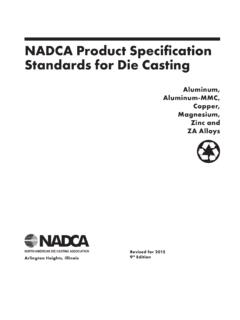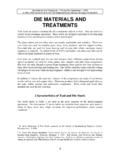Transcription of Chapter 3 - Alloy Data - Die casting
1 Alloy DataNADCA Product Specification Standards for Die Castings / Section 3 / 20033-2 The cross reference designa-tions shown are for Alloy speci-fications according to widely recognized sources. Refer-ences apply to the metal in the die cast condition and should not be confused with similar specifications for metal ingot. A in a column indicates that the specific Alloy is not regis-tered by the given SymbolsUNS Unified Numbering SystemANSI American National Standards InstituteASTM American Society for Testing and MaterialsAA Aluminum AssociationSAE Society of Automotive EngineersFED Federal SpecificationsMIL Military SpecificationsJIS Japanese Industrial StandardDIN German Industrial Standard1 Die casting Alloy Cross Reference Designations Similar to preceding entry with slight variations in minor constituents.
2 The Federal specification for alumi-num Alloy die castings uses the Aluminum Association designations for individual alloys . Military designations superseded by Federal specifications. Japanese specifications allow magnesium maximum. Japanese specifications allow zinc maximum. DIN 1725 spec allows max zinc and up to max magnesium. DIN 1725 spec allows max magnesium. Alloy compositions shown in DIN 1725 tend to be primary based and have low impurity limits making it difficult to correlate directly to : Some of these standards are obsolete but included here for historical purposes. For closest cross-reference refer to the tables of foreign Alloy designations and chemical constituencies at the end of this 3-1 Aluminum Alloy SpecificationsComm' 341 Table 3-2 Aluminum Metal Matrix Composite Alloy Data3 NADCA Product Specification Standards for Die Castings / Section 3 / 20033-3 ASTMB176 Table 3-3 Copper Alloy SpecificationsComm'lUNSSAEJ461/857C85700 858C85800Z30AJ462865C86500 878C87800ZS144AJ462997C99700 JISH2222 &H5303 Table 3-4 Magnesium Alloy SpecificationsComm'lUNSF ormerSAEJ465 BASTMB93 &B94 FederalDIN1729AZ91BM11912AZ91B501 AQQ-M38AZ91DM11916AZ91D MDI1 DAZ81
3 AM60AM10600AM60A MDI2 AAM60BM10602AM60B MDI2 BAM50 AE42 AS41AM10410AS41A AS41BM10412AS41B AM20 MDI3A Table 3-5 Zinc and ZA Alloy SpecificationsComm'lUNSF ormerSAEJ469 FederalDINJISQQ-Z-363aASTMB862Z35541AC43 A921AC43A3Z33520AG40A903AG40 AZDC-25Z355310AC41A925AC41A7Z33523AG40B AG40 BZA-8Z35636 ZA-12Z35631 ZA-27Z35841 174317431743 ZDC-1 Table SymbolsUNS Unified Numbering SystemANSI American National Standards InstituteASTM American Society for Testing and MaterialsAA Aluminum AssociationSAE Society of Automotive EngineersFED Federal SpecificationsMIL Military SpecificationsJIS Japanese Industrial StandardDIN German Industrial StandardAlloy DataNADCA Product Specification Standards for Die Castings / Section 3 / 20033-4 : Aluminum Die casting Alloys2 Selecting Aluminum AlloysAluminum (Al) die casting alloys have a specific gravity of approximately g/cc, placing them among the lightweight structural metals.
4 The majority of die cast-ings produced worldwide are made from aluminum major elements constitute the die cast aluminum Alloy system: silicon, copper, magnesium, iron, manganese, and zinc. Each element affects the Alloy both inde-pendently and aluminum Alloy subsection presents guideline tables for chemical composition, typical properties, and die casting , machin-ing and finishing characteristics for 11 aluminum die casting alloys . This data can be used in combination with design engi-neering tolerancing guidelines for aluminum die casting and can be compared with the guidelines for other alloys in this section and in the design engineering A380 (ANSI/AA ) is by far the most widely cast of the aluminum die casting alloys , offering the best combination of material properties and ease of produc-tion.
5 It may be specified for most product applications. Some of the uses of this Alloy include electronic and communications equipment, automotive components, engine brackets, transmission and gear cases, appliances, lawn mower housings, furniture components, hand and power 383 (ANSI/AA ) and Alloy 384 (ANSI/AA ) are alternatives to A380 for intricate components requiring improved die filling characteristics. Alloy 383 offers improved resistance to hot cracking (strength at elevated temperatures). Alloy A360 (ANSI/AA ) offers higher corrosion resistance, superior strength at elevated temperatures, and somewhat better ductility, but is more difficult to not in wide use and difficult to cast, Alloy 43 (ANSI/AA ) offers the highest ductility in the aluminum family.
6 It is moderate in corrosion resistance and often can be used in marine grade A13 (ANSI/AA ) offers excel-lent pressure tightness, making it a good choice for hydraulic cylinders and pressure vessels. Its casting characteristics make it useful for intricate 390 (ANSI/AA ) was devel-oped for automotive engine blocks. Its resistance to wear is excellent; its ductility is low. It is used for die cast valve bodies and compressor housings in 218 (ANSI/AA ) provides the best combination of strength, ductility, cor-rosion resistance and finishing qualities, but it is more difficult to die CharacteristicsMachining characteristics vary somewhat among the commercially available alu-minum die casting alloys , but the entire group is superior to iron, steel and tita-nium.
7 The rapid solidification rate associ-ated with the die casting process makes die casting alloys somewhat superior to wrought and gravity cast alloys of similar chemical A380 has better than average machining characteristics. Alloy 218, with magnesium the major alloying element, exhibits among the best machinability. Alloy 390, with the highest silicon content and free silicon constituent, exhibits the Treatment SystemsSurface treatment systems are applied to aluminum die castings to provide a deco-rative finish, to form a protective barrier against environmental exposure, and to improve resistance to finishes can be applied to aluminum die castings through painting, powder coat finishing, polishing, epoxy finishing, and plating.
8 Aluminum can be plated by applying an initial immersion zinc coating, followed by conventional copper-nickel-chromium plating procedure similar to that used for plating zinc against environmental corro-sion for aluminum die castings is achieved through painting, anodizing, chromating, and iridite wear resistance can be achieved with aluminum die castings by hard a part design does not allow the production of a pressure-tight die cast-ing through control of porosity by gate and overflow die design, the location of ejector pins, and the reconfiguration of hard-to-cast features, impregnation of aluminum die castings can be used.
9 Systems employ- Alloy Data3 NADCA Product Specification Standards for Die Castings / Section 3 / 20033-5 : Aluminum Die casting Alloy CompositionNADCAA-3-1-03 Standard
10 Analysis shall ordinarily be made only for the elements mentioned in this table. If, however, the presence of other elements is suspected, or indi-cated in the course of routine analysis, further analysis shall be made to determine that the total of these other elements are not present in excess of specified limits.









